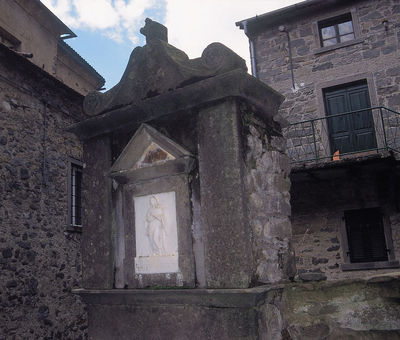The faces in the rock are not recent
Lunigiana is a land full of myths and legends, and the origins of many are lost in the mists of time. In Comano, as in other nearby municipalities, it is easy to find faces carved into the stone, roughly-hewn sculptures that you can spot above doors or on the walls of houses: angels and demons, curly-haired cherubs and the faces of spirits. This place always exudes a certain atmosphere, and perhaps that is exactly what was intended.
Studies have been able to date some of these sculptures to the sixteenth and seventeenth centuries. But archaeologists are adamant: the Celts were carving faces into the rock long before that, meaning to ward malign spirits away from their homes. There are signs, indeed, of prehistoric carvings in the rocks here. If you want to see any of them, ask the locals to show you: just to make a good impression, use their dialect word for them: facion.
The Maestà: the protective, instructive, votive buildings
The people in these parts have not lost their respect for
nature, for nature rules supreme. Everyone speaks of a past, but also of a
present, where man is not the master but the guest of the landscape, which is
often hard and hostile. We are in the mountains at the edge of Emilia Romagna,
surrounded by peaks more than two thousand metres high. Today, this is the
realm of trekkers, who enjoy the clear paths and breathtaking views; in the
past, though, inhabiting or crossing these parts was a perilous business. It is for this reason that one finds so
many little votive buildings around here, known as maestà. Made of stone and tiles, they were built to protect
travellers and purify the soil, once the scene of pagan rituals. The faithful,
many of whom were illiterate, could also learn lessons of the catechism here by
following the decorative images and hearing biblical stories read to them. The maestà are therefore found all along the
mountain passes, but also on top of houses and near wells. Even today people
gather at them, and there are trekking routes designed specifically as
"vie della Maestà."
A road once vital but deadly
A borderland with many a mountain pass, and some commanding views. But if today this is nothing more than a nice trip outdoors, in the past it must have been exhausting, not to say dangerous. The place names reveal much: the pass that was used to facilitate trade with Rome and Lucca cuts through a mountain called "Malpasso", which suggests how taxing it was to cross. Yet this road was fundamental, even in ancient times, as one of the main routes between the Po floodplain and Tuscany. Today you can climb through the woods to Monte Acuto, and from there to the pass of Lagastrello, next to the lake of the same name. The ridge runs at an altitude of some two thousand metres: a path suspended between two worlds, changing with the seasons as the colours, emotions, smells and views fade away and renew.



